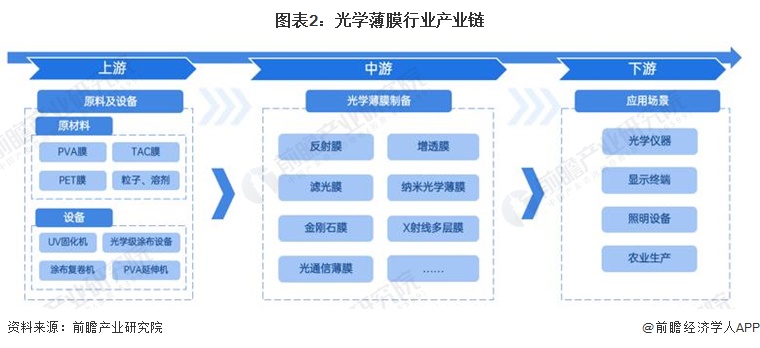Core data of this article: Industry chain; Optical film market size
Industry Overview
1. Definition
Optical thin film refers to a layer or multiple layers of dielectric film or metal film or a combination of these two films that are plated or coated on an optical element or an independent substrate to change the transmission characteristics of light waves, including light transmission, reflection, absorption, scattering, polarization and phase change. Since optical thin film products are usually used in combination and are mainly used in the display field, in a narrow sense, optical films can be roughly divided into two categories: optical films for liquid crystal panels and optical films for backlight modules. According to the different characteristics of optical films, optical films are mainly divided into reflective films, anti-reflection films (also called anti-reflection films), dichroic films, filter films, brightness enhancement films, diffusion films, polarizers (full name polarizers), etc.

2. Analysis of the industrial chain: Optical film is the key link of development
The upstream of the optical film industry chain includes OVA film, TAC film, PET film and other materials and equipment; the midstream is the optical film preparation companies, the main companies include Double Star New Materials, Jizhi Technology, Double Star New Materials, Jizhi Technology, 光学薄膜行业产业链上游包括OVA膜、TAC膜、PET膜等材料及设备;中游为光学薄膜制备企业,主要企业包括双星新材、激智科技、Daoming Optics, etc.; downstream is the application scenarios of optical film products, including optical instruments, display terminals, lighting equipment, agricultural production and other scenarios.


Industry development history: The industry is in a period of rapid development
From the early 19th century to the end of the 20th century, scientists in Germany, the United States and other countries made continuous achievements in the exploration of the basic scientific principles of optical films. The world's first batch of anti-reflection films were born, and various properties of optical films were gradually discovered. In the early 20th century, the technology and preparation process of optical film preparation equipment and coating product types were developed, and the oil diffusion pump of the vacuum coating machine for manufacturing optical films appeared. Optical films have been truly widely used in optical systems as a type of practical optical components.
The development of China's optical film industry started late and can be roughly divided into three development stages. In the initial stage, my country's first polarizer was successfully produced in 1994, and the first optical film production line was established in 2004. During this period, the market was monopolized by companies from Japan, the United States and other countries, and the Chinese market was heavily dependent on imports; in the initial development stage, as the LCD panel industry began to shift to China, China's optical film industry began to develop rapidly. During this period, the number of production lines increased and production capacity increased; during the rapid development stage, the government introduced a number of policies to encourage and support the development of the optical film industry. During this period, the number of new companies increased rapidly, production capacity expanded rapidly, independent core intellectual property rights were formed faster, and the types of domestic products replacing imports gradually increased.

行业政策背景:促进光学薄膜材料高端化、国产化
光学薄膜是我国战略新材料产业,光学薄膜的高产化、高端化是中国光学仪器、显示器件等现代产业发展的重要基础。国家出台了一系列政策,重点发展光学薄膜等新材料产品,促进光学薄膜产业的国产替代。

行业供需现状:光学薄膜市场规模快速增长
1、外资与内资企业共同竞争
从中国光学薄膜企业主体类型来看,国内光学薄膜行业主要包括中国本土企业以及外资/合资企业。本土企业主要包括双星新材、激智科技、裕兴股份等;外资企业主要包括三菱化学、爱思开希等等。

2、光学薄膜规模持续增长
光学薄膜是中国功能性膜材料市场的主要产品。得益于下游面板、消费电子产品需求的稳定增长,中国光学薄膜需求规模持续扩大。中国光学薄膜产业规模由2019年的接近350亿元提升至2023年的超过430亿元。

行业竞争格局
1、外资占据高端市场
综合来看,目前中国光学薄膜市场主要是日本、韩国的国际厂商占据高端市场份额,如偏光片、高端增亮膜等,其核心基材如PVA、TAC等产品被掌握在国际厂商中,中国主要依赖进口或只能生产中低端产品;但部分光学薄膜产品中国企业已取得优异的进步,市场竞争力不断提高。

目前,中国光学薄膜行业大陆头部企业主要有双星新材、激智科技、长阳科技、东材科技等,结合中国光学薄膜行业市场规模及头部企业光学薄膜业务营收情况,初步测算,中国光学薄膜行业头部企业CR5市场份额约15%,目前中国光学薄膜行业市场集中度较低。

2、区域市场:广东、江苏发展优势明显
从区域分布情况来看,中国光学薄膜企业主要分布在广东、江苏、浙江等沿江和沿海发达省市和地区。中国光学薄膜企业区域分布十分集中。

行业发展前景预测
1、应用需求升级推动市场规模增长
中国已经成为全球最大的消费电子产品生产国、出口国和消费国,随着中国人均收入水平的不断提高,消费者对液晶电视、手机、电脑等消费类电子产品品质要求不断提升,更新换代频率加快,长远看需求依然强劲。而伴随着5G技术、物联网技术的发展,穿戴式产品、家庭居住等新型智能硬件产品迅猛发展,光学薄膜产品下游产品范围不断延伸,新型应用场景的不断丰富,也将带动光学薄膜的下游市场需求增长。预计中国光学薄膜行业市场规模将以接近6.2%的增速保持增长,2028年产业规模将接近600亿元。

2、光学薄膜行业发展集聚化、高端化、自给化
中国光学薄膜行业伴随着新进入者增多以及国产替代逻辑的演进,未来市场竞争将会进一步加剧。在技术上,除了在透光率、雾度等指标的不断精进,光学薄膜也往复合化、集约化方向发展,更轻薄的厚度、占据更小的空间,但能实现更丰富的功能。

更多本行业研究分析详见前瞻产业研究院《中国光学薄膜行业深度调研与投资战略规划分析报告》。
同时前瞻产业研究院还提供产业新赛道研究、投资可行性研究、产业规划、园区规划、产业招商、产业图谱、产业大数据、智慧招商系统、行业地位证明、IPO咨询/募投可研、专精特新小巨人申报等解决方案。在招股说明书、公司年度报告等任何公开信息披露中引用本篇文章内容,需要获取前瞻产业研究院的正规授权。
更多深度行业分析尽在【前瞻经济学人APP】,还可以与500+经济学家/资深行业研究员交流互动。更多企业数据、企业资讯、企业发展情况尽在【企查猫APP】,性价比最高功能最全的企业查询平台。


